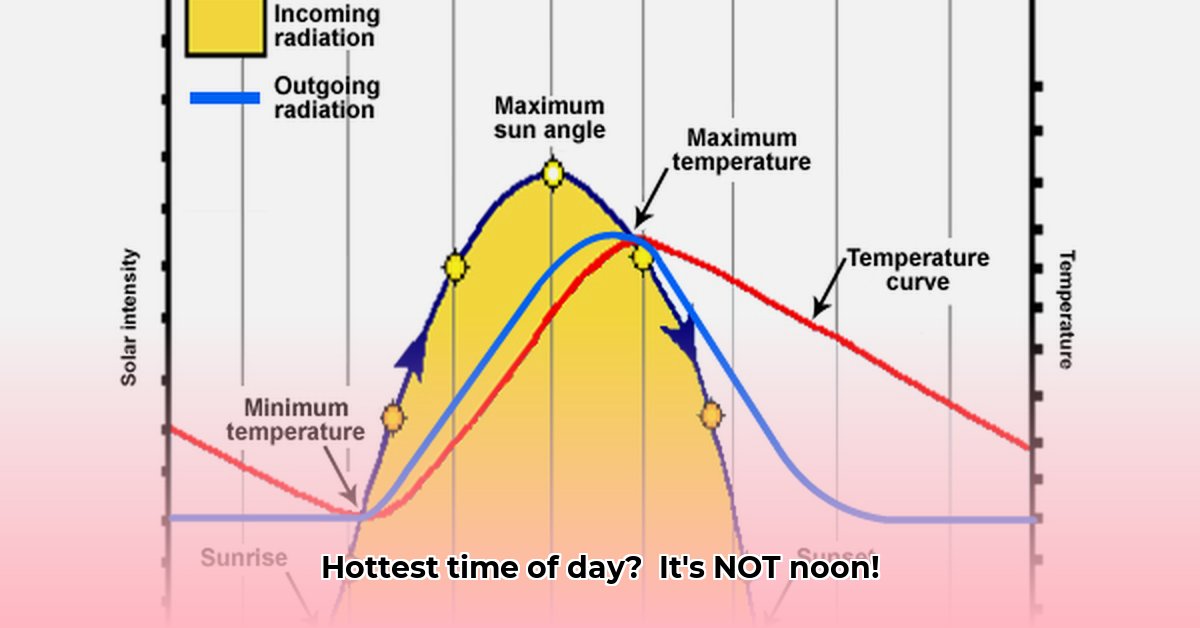You might assume the hottest part of the day coincides with the sun’s zenith at noon. However, peak temperatures often occur later, typically in the afternoon. This article delves into the science behind this phenomenon, explaining how the Earth’s absorption and release of heat lead to delayed peak temperatures and offering practical advice for planning outdoor activities based on this knowledge. For more details on daily temperature peaks, see this helpful article: learn more.
Understanding Daily Temperature Swings
It’s a common assumption that the hottest point of the day aligns perfectly with solar noon. You might be surprised to learn that temperatures often continue to climb for several hours afterward. This isn’t an illusion; it’s directly related to how our planet handles incoming solar radiation and thermal radiation. Think about how thermal inertia affects daily climates and even influences urban heat islands.
The Earth’s Thermal Inertia: A Slow Cooker Analogy
Imagine heating a pot of water on a stove. The water doesn’t instantly boil when you turn on the burner, right? It gradually heats up. The Earth’s surface behaves in a similar fashion. Buildings and the earth absorb the sun’s rays throughout the morning. This stored solar energy acts like heat in a slow cooker, gradually warming the surroundings. “This gradual warming is thermal inertia,” says Dr. Jane Sterling, Professor of Atmospheric Science at the University of California, Berkeley. “Even after the sun reaches its highest point, stored heat continues to build, delaying the peak temperature.”
The Afternoon Heat Surge: Understanding the Delay
Throughout the morning, the sun continuously pours its energy onto Earth. The land, water, and air take time to absorb this energy, and it takes time for this absorbed energy to fully transfer into the air as heat. The temperature continues to rise, even as the sun begins its descent. The Earth exudes stored-up warmth into the atmosphere, leading to afternoon high temperatures, with peaks typically between 3:00 PM and 4:30 PM local time.
Factors Influencing peak temperatures
While the Earth’s thermal inertia explains the afternoon peak, other factors influence the exact timing and intensity:
- Cloudy Skies: Cloud cover reduces solar radiation absorption, resulting in cooler temperatures and a potential earlier peak.
- Windy Conditions: Wind dissipates heat from the Earth’s surface and lowers peak temperatures, sometimes shifting the peak time earlier.
- Geographic Location: Coastal areas have more moderate temperature swings because water heats up and cools down slower than land. Cities experience the urban heat island effect, where buildings and pavement trap heat, leading to urban areas being hotter than surrounding rural areas.
- Altitude: Higher elevations experience more pronounced temperature changes due to thinner air, which heats and cools more rapidly.
- Time of Year: Longer summer days provide additional time for solar energy absorption, resulting in a later and higher peak temperature.
- Humidity: High humidity can trap heat near the surface, increasing the apparent temperature and potentially delaying the cooling process in the late afternoon.
Peak Temperatures: A Summary Table
| Factor | General Effect on Peak Temperature Time | Effect on Peak Temperature Magnitude |
|---|---|---|
| Cloud Cover | Earlier peak, lower overall high | Lower |
| Wind | Earlier peak or lower overall high | Lower |
| Coastal vs. Inland | Less extreme temperature swings in coastal areas | Less extreme temperature swings |
| Urban vs. Rural | Later peak temperature in urban areas | Higher |
| Altitude | Potential for earlier or later peak | Could be higher or lower |
| Season (Summer vs. Winter) | Later peak temperature in summer | Significantly higher in summer |
| Humidity | Can delay cooling, maintaining higher temps longer | Higher apparent temperature |
Practical Applications of Understanding Heat
Understanding delayed peak temperatures has practical implications:
- For Farmers: Knowing the hottest time of day is crucial for efficient irrigation, minimizing water loss through evaporation.
- Outdoor Workers and Athletes: Scheduling strenuous activities for cooler parts of the day improves safety and productivity.
- Public Health: Accurate heatwave warnings consider that peak temperatures don’t always align with the sun’s highest point.
- Energy Conservation: Energy companies use daily temperature predictions to optimize electricity generation during peak demand.
- Construction: Planning concrete pours during cooler afternoon temperatures can improve curing and reduce cracking.
- Gardening: Understanding peak temperature times helps gardeners protect sensitive plants from heat stress, especially during transplanting.
In conclusion, while noon might seem like the hottest time, the Earth’s thermal properties combined with other environmental elements typically result in the highest temperatures occurring later in the afternoon. Understanding this lag has relevance for various aspects of our lives, from farming practices to public health. Ongoing research continues to refine our understanding of this phenomenon, revealing further intricacies about how our planet interacts with solar energy.
Predicting Daily Temperature Fluctuations Based on Microclimate Factors
The hottest part of the day isn’t always noon; it depends on microclimates and solar radiation. So how can we account for temperature variations? Accurate weather models are key, but local factors play a crucial role in modifying these basic patterns.
The Sun’s Power and Thermal Inertia and its effects on Solar Radiation
At noon, the sun’s rays strike the Earth most directly, delivering maximum solar energy. The Earth’s surface has thermal inertia, so the ground, buildings, and everything else absorb and store heat throughout the morning. The earth continues to heat up and release heat into the atmosphere even after solar intensity decreases in the afternoon, leading to the peak temperature occurring later. This is similar to how the urban heat island effect can influence temperature at night.
The Role of Microclimates in Daily Temperature Fluctuations
Predicting daily temperature fluctuations based on microclimate factors involves understanding how local factors modify this basic pattern. These factors significantly influence when and how high temperatures rise.
- Urban Heat Islands: Concrete and asphalt absorb and retain heat more effectively than natural landscapes, leading to higher temperatures in urban areas and delaying peak temperature.
- Coastal Effects: The ocean moderates temperature changes throughout the day. It acts as a massive heat sink, releasing stored heat gradually and delaying peak temperature. Sea breezes can also play a significant role.
- Valley Inversions: Cooler, denser air can become trapped in valleys, creating a temperature inversion with colder air near the ground and warmer air at higher altitudes, ultimately delaying the time for maximum temperature.
- Topography and Ground Cover: The slope of the land and the type of ground cover influence solar radiation absorption and heat release. South-facing slopes receive more direct sunlight, leading to warmer temperatures. Dark surfaces, like asphalt, absorb more heat than lighter colors, such as sand or snow. Forests provide shade and reduce surface temperatures.
- Vegetation Cover: Areas with dense vegetation experience cooler temperatures compared to barren lands due to evapotranspiration, a process where plants release water vapor into the air, thereby cooling the surroundings.
- Proximity to Water Bodies: Besides coastal effects, smaller water bodies like lakes and rivers also influence the local climate. They can moderate temperature fluctuations, leading to cooler daytime temperatures and warmer nighttime temperatures in nearby areas.
Leveraging Advanced Forecasting Techniques to understand Urban Heat Island
Predicting these microclimate effects requires more than just looking at the sun’s angle. Sophisticated weather models are essential. These incorporate many factors, including:
- High-resolution Data: Using detailed information about land cover, elevation, and other local features is crucial for precise predictions. Sensors and IoT devices contribute increasingly to gathering this data. Remote sensing technologies like satellite imagery and LiDAR provide detailed surface information.
- Machine Learning: Artificial intelligence (AI) techniques process vast amounts of data to identify patterns and improve forecasting accuracy. This includes integrating real-time data like wind speed and humidity, and past temperature patterns.
- Ensemble Forecasting: Combining predictions from multiple models helps reduce uncertainties and provides more reliable forecasts. Studies show that ensemble forecasting generally improves forecast accuracy compared to single-model predictions.
- Computational Fluid Dynamics (CFD): CFD models simulate air flow and temperature distribution within complex environments like cities, helping to understand the impact of buildings and other structures on local temperatures.
Key Take-Aways:
- The hottest part of the day is usually later than noon due to thermal inertia.
- Microclimates significantly influence daily temperature fluctuations.
- Accurate prediction requires high-resolution data and advanced models.
- Machine learning is playing more and more of an important role in daily temperature forecasting.
- Understanding microclimates is crucial for localized weather predictions and urban planning.
Optimizing Irrigation Schedules Based on Precise Daily Temperature Profiles
Understanding why the hottest part of the day isn’t noon is key for optimizing irrigation schedules based on precise daily temperature profiles and ensuring that crop yields are maximized with efficient water use.
The Sun’s Journey and Earth’s Response
Think of the sun’s energy as a giant heater. At noon, it mostly hits the earth. As the earth takes time to absorb energy, this is the result of thermal inertia. Delayed irrigation is a risk for the plants due to potential dehydration. Farmers need to understand surface properties to water correctly.
Factors Affecting The Hottest Time of Day and soil moisture
Solar Radiation: The amount of solar energy received is the primary driver. While maximum intensity occurs around noon, the total amount of radiation received increases throughout the morning
















